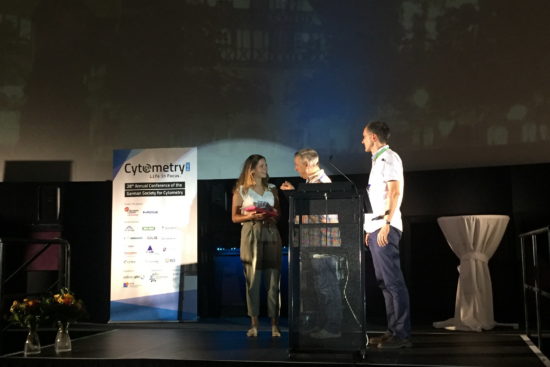DGfZ Meeting in Jena: Poster award for Lisa Budzinski
28th Annual Conference of the German Society for Cytometry: More than counting cells
For the second time in a row, the Leibniz Institute of Photonic Technology (Leibniz IPHT) organized and hosted the „Annual Conference of the German Society for Cytometry“(DGfZ). Nearly 160 national and international scientists attended this years’s conference themed „Life in Focus“. The event was held at the Friedrich Schiller University in Jena from September 19-21.
http://www.dgfz.org/
Poster Prize
A prize will be awarded for the best poster presented at the Annual Conferences of the DGfZ.
This prize will be annonced after the poster session during the meeting.
| Winner | Year | Title of work |
| Lisa Budzinski | 2018 | Osmium-labeled microspheres for bead-based assays in mass cytometry |
Polystyrene microspheres are broadly applied in flow cytometry for instrument setup and monitoring instrument stability, for assessing fluorescent spillover and in various cytometric assays e. g. for absolute quantification of cellular receptors and multi-analyte profiling. The implementation of bead-based assays in mass cytometry for the same purposes is strongly desired but hampered by the lack of functionalized beads associated with sufficient amounts of heavy metal allowing for the unequivocal detection of these by the mass cytometer.
We here introduce osmium tetroxide labeling for polystyrene microspheres as a simple, quick, and universal approach to produce various kinds of functionalized beads applicable in mass cytometry. Osmium detection does not interfere with any existing reagents routinely used in mass cytometric assays, and osmium labeling of various commercially available antibody capture beads resulted in stably and uniformly labeled beads, while retaining their antibody-capture functionality. Osmium-labeled antibody capture beads retained both their functionality and osmium signal for at least two weeks when stored at -80 °C.
We show that osmium-labeled antibody capture beads can be employed for uncompromised characterization of metal-antibody conjugates, and for signal spillover assessment in complex mass cytometric data sets resulting from e.g. minor isotopic impurities of metal labels. Furthermore, osmium-labeled beads facilitate the absolute quantification of cell-surface receptors in mass cytometry.
Osmium labeling of polystyrene beads permits robust implementation of beads-based assays in mass cytometry, broadening the applicability of mass cytometry in biomedical and basic research, and increasing the quality and quantity of information retrievable in mass cytometric studies.

 English
English

